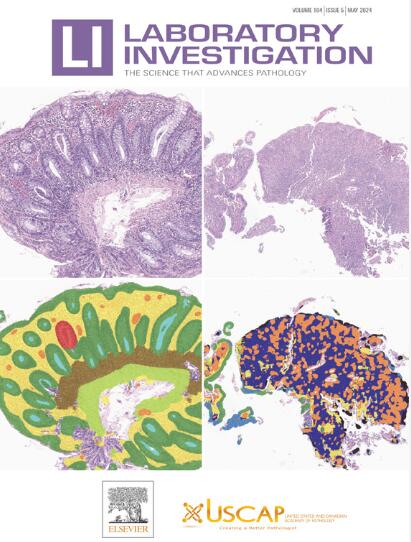Clinicopathologic Features and the Spectrum of Myelokathexis in Warts, Hypogammaglobulinemia, Infections, Myelokathexis Syndrome
IF 4.2
2区 医学
Q1 MEDICINE, RESEARCH & EXPERIMENTAL
引用次数: 0
Abstract
Warts, hypogammaglobulinemia, infections, myelokathexis (WHIM) syndrome is a rare primary immunodeficiency disorder predominantly caused by germline CXCR4 variants. Bone marrow (BM) evaluation showing myelokathexis helps to establish the diagnosis of WHIM syndrome, but unfamiliarity with pertinent diagnostic features and variability in morphologic and clinical findings may result in disease underrecognition. We aimed to characterize the clinical, BM, and peripheral blood (PB) features of 30 patients with germline CXCR4 variants, including genotype–phenotype analysis and correlation between morphologic features and functional CXCR4 receptor internalization defect. We also aimed to examine PB features of a mouse model of WHIM syndrome (Cxcr4+/1013) and examine WHIM syndrome and WHIM mouse PB morphologic changes after CXCR4 antagonist therapy. Carboxy-terminal nonsense/frameshift CXCR4 variants were associated with myelokathectic neutrophil morphology in 32% to 80% (median, 66%) and 4% to 14% (median, 9%) of total neutrophils in the BM and PB, respectively. In contrast, myelokathectic neutrophils were infrequent in 5 missense CXCR4 variants (3 CXCR4D84H and 2 CXCR4S341Y). Compared with neutropenic controls, carboxy-terminal CXCR4 nonsense/frameshift variants were associated with >10% BM or >5% PB myelokathectic neutrophils (100% specific; 100% [BM] or 93% [PB] sensitive), as well as more frequent neutrophil apoptosis (BM, P = .0093; PB, P < .0001), dysmorphic/vacuolated eosinophils (BM, P = .012; PB, P < .0001), neutrophil vacuolization (BM, P < .0001), and nonparatrabecular neutrophil clusters in the BM (P = .0059). BM myeloid hyperplasia occurred in 54% of carboxy-terminal CXCR4 nonsense/frameshift variants and in no controls. BM myelokathectic neutrophil percentage correlated with the functional CXCR4 internalization defect (P ≤ .0042). Like humans, WHIM mice (Cxcr4+/1013) demonstrated circulating myelokathectic-like neutrophils with nuclear hypersegmentation. CXCR4 antagonist therapy in patients with WHIM syndrome (n = 5) and mice increased both morphologically normal and myelokathectic neutrophils in PB. We demonstrated notable genotype–phenotype heterogeneity between CXCR4 variants and myelokathexis, which correlates with functional CXCR4 internalization defect. The morphologic features of WHIM syndrome may be subtle, resulting in misdiagnosis. We described key morphologic features that are useful to facilitate diagnosis.
疣、低γ -球蛋白血症、感染、骨髓疏松综合征的临床病理特征和谱
疣、低γ球蛋白血症、感染、骨髓增生症(WHIM)综合征是一种罕见的原发性免疫缺陷疾病,主要由种系CXCR4变异引起。骨髓(BM)评估显示骨髓疏松有助于确定WHIM综合征的诊断,但不熟悉相关的诊断特征以及形态学和临床表现的变异性可能导致对疾病的认识不足。我们旨在描述30例种系CXCR4变异患者的临床、BM和外周血(PB)特征,包括基因型-表型分析以及形态学特征与功能性CXCR4受体内化缺陷之间的相关性。我们还旨在检测WHIM综合征小鼠模型(Cxcr4+/1013)的PB特征,并检测Cxcr4拮抗剂治疗后WHIM综合征和WHIM小鼠PB形态学的变化。羧基端无义/移码CXCR4变异分别与BM和PB中32%至80%(中位数,66%)和4%至14%(中位数,9%)的中性粒细胞形态相关。相比之下,在5个错义CXCR4变异(3个CXCR4D84H和2个CXCR4S341Y)中,骨髓中性粒细胞并不常见。与嗜中性粒细胞减少对照组相比,羧基端CXCR4无义/移码变异与10% BM或5% PB相关(100%特异性;100% [BM]或93% [PB]敏感),以及更频繁的中性粒细胞凋亡(BM, P = 0.0093;PB, P <;.0001),畸形/空泡性嗜酸性粒细胞(BM, P = .012;PB, P <;.0001),中性粒细胞空泡化(BM, P <;.0001), BM中的非细胞旁中性粒细胞聚集(P = .0059)。54%的羧基末端CXCR4无义/移码变异体发生骨髓增生,没有对照组。骨髓中性粒细胞百分比与功能性CXCR4内化缺陷相关(P≤0.0042)。与人类一样,WHIM小鼠(Cxcr4+/1013)表现出具有核超分割的循环髓细胞样中性粒细胞。WHIM综合征患者(n = 5)和小鼠的CXCR4拮抗剂治疗增加了PB中形态正常和骨髓中性粒细胞。我们证明了CXCR4变异与骨髓增生之间显著的基因型-表型异质性,这与功能性CXCR4内化缺陷有关。WHIM综合征的形态学特征可能很微妙,导致误诊。我们描述了有助于诊断的关键形态学特征。
本文章由计算机程序翻译,如有差异,请以英文原文为准。
求助全文
约1分钟内获得全文
求助全文
来源期刊

Laboratory Investigation
医学-病理学
CiteScore
8.30
自引率
0.00%
发文量
125
审稿时长
2 months
期刊介绍:
Laboratory Investigation is an international journal owned by the United States and Canadian Academy of Pathology. Laboratory Investigation offers prompt publication of high-quality original research in all biomedical disciplines relating to the understanding of human disease and the application of new methods to the diagnosis of disease. Both human and experimental studies are welcome.
 求助内容:
求助内容: 应助结果提醒方式:
应助结果提醒方式:


